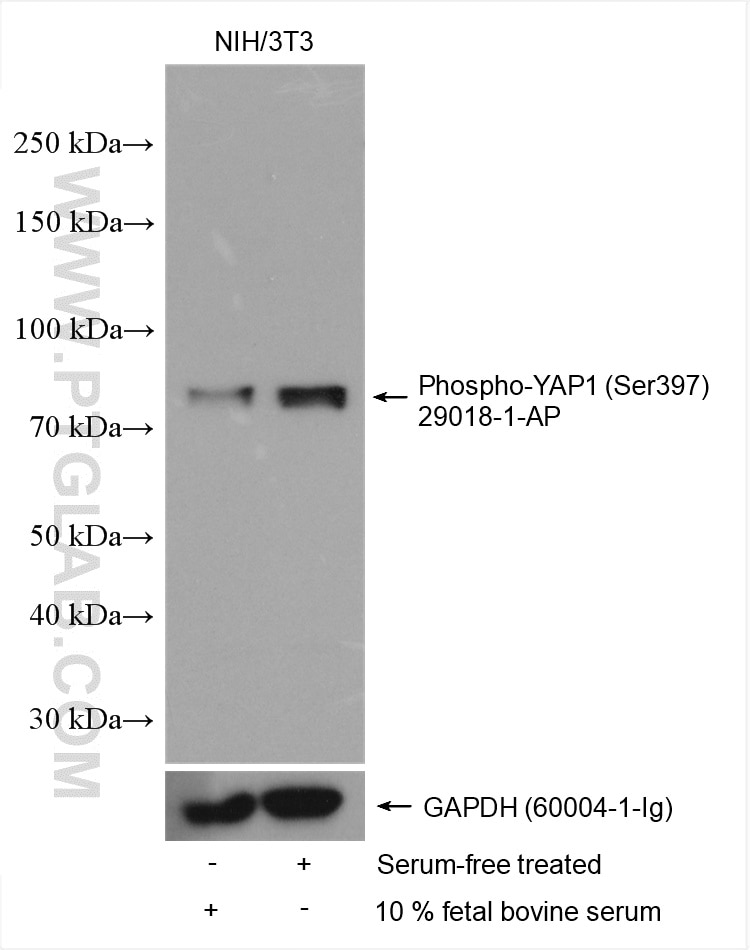Anticorps Polyclonal de lapin anti-Phospho-YAP1 (Ser397)
Phospho-YAP1 (Ser397) Polyclonal Antibody for WB, ELISA
Hôte / Isotype
Lapin / IgG
Réactivité testée
Humain, souris et plus (1)
Applications
WB, IHC, IF, ELISA
Conjugaison
Non conjugué
N° de cat : 29018-1-AP
Synonymes
Galerie de données de validation
Applications testées
| Résultats positifs en WB | Serum-free treated NIH/3T3 cells, cellules NIH/3T3 traitées au sérum fœtal de bovin à 10 % |
Dilution recommandée
| Application | Dilution |
|---|---|
| Western Blot (WB) | WB : 1:2000-1:16000 |
| It is recommended that this reagent should be titrated in each testing system to obtain optimal results. | |
| Sample-dependent, check data in validation data gallery | |
Applications publiées
| WB | See 25 publications below |
| IHC | See 2 publications below |
| IF | See 1 publications below |
Informations sur le produit
29018-1-AP cible Phospho-YAP1 (Ser397) dans les applications de WB, IHC, IF, ELISA et montre une réactivité avec des échantillons Humain, souris
| Réactivité | Humain, souris |
| Réactivité citée | rat, Humain, souris |
| Hôte / Isotype | Lapin / IgG |
| Clonalité | Polyclonal |
| Type | Anticorps |
| Immunogène | Peptide |
| Nom complet | Yes-associated protein 1, 65kDa |
| Masse moléculaire calculée | 504 aa, 54 kDa |
| Poids moléculaire observé | 75 kDa |
| Numéro d’acquisition GenBank | BC038235 |
| Symbole du gène | YAP1 |
| Identification du gène (NCBI) | 10413 |
| Conjugaison | Non conjugué |
| Forme | Liquide |
| Méthode de purification | Purification par affinité contre l'antigène |
| Tampon de stockage | PBS with 0.02% sodium azide and 50% glycerol |
| Conditions de stockage | Stocker à -20°C. Stable pendant un an après l'expédition. L'aliquotage n'est pas nécessaire pour le stockage à -20oC Les 20ul contiennent 0,1% de BSA. |
Informations générales
The transcriptional factors Yes-associated protein 1 (YAP1) and PDZ-binding motif (TAZ) act as downstream effectors of the Hippo pathway, and their subcellular location and transcriptional activities are affected by multiple post-translational modifications (PTMs). After phosphorylation, YAP1/TAZ binds to the 14-3-3 protein, which induces cytoplasmic retention of YAP1/TAZ. Moreover, phosphorylated YAP1/TAZ is likely to undergo ubiquitination degradation that is dependent on the β-transducin repeat-containing E3 ubiquitin protein ligase complex. The phosphorylation of YAP at Ser127 promotes its cytoplasmic retention, whereas phosphorylation at Ser397 induces degradation. (PMID: 29682330, PMID: 26039999)
Protocole
| Product Specific Protocols | |
|---|---|
| WB protocol for Phospho-YAP1 (Ser397) antibody 29018-1-AP | Download protocol |
| Standard Protocols | |
|---|---|
| Click here to view our Standard Protocols |
Publications
| Species | Application | Title |
|---|---|---|
Front Immunol The role of YAP1 in survival prediction, immune modulation, and drug response: A pan-cancer perspective | ||
Int Immunopharmacol ASIC1a regulates ferroptosis in hepatic stellate cells via the Hippo/Yap-1 pathway in liver fibrosis | ||
Int Immunopharmacol Ischemia-inhibited ferric chelate reductase 1 improves ferroptosis-mediated intestinal ischemia injury via Hippo signaling | ||
Sci Rep Gingival proteomics reveals the role of TGF beta and YAP/TAZ signaling in Raine syndrome fibrosis | ||
Mol Cell Biochem RNF144A-AS1 stabilizes TAF15 and promotes malignant biological behaviors of skin cutaneous melanoma |
Avis
The reviews below have been submitted by verified Proteintech customers who received an incentive for providing their feedback.
FH Udesh (Verified Customer) (08-19-2024) | Worked well to detect pYAP at 70 kDa
 |


